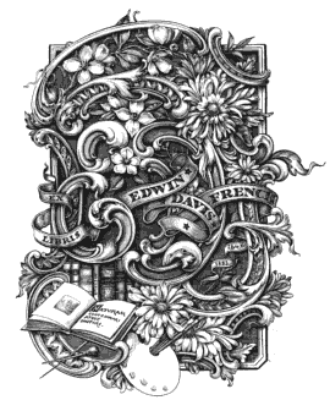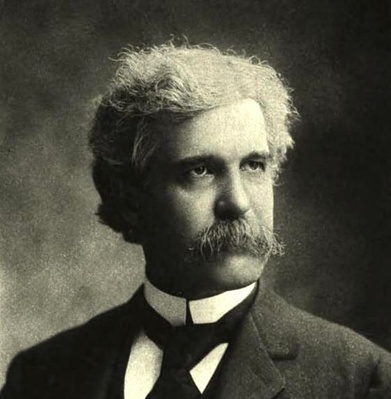 Edwin Davis French's bookplate(from Edwin Davis French: a memorial; his life, his art, by Mary Brainerd French
Edwin Davis French's bookplate(from Edwin Davis French: a memorial; his life, his art, by Mary Brainerd French  Edwin Davis French (from Edwin Davis French: a memorial; his life, his art, by Mary Brainerd French
Edwin Davis French (from Edwin Davis French: a memorial; his life, his art, by Mary Brainerd French
Died: 1906
Married: Mary Olivia Brainerd
Children:
Edwin Davis French was a noted bookplate engraver; he produced at least 330 plates beginning in 1893.
His health was frail from childhood, and he was by nature literary and artistic. He entered Brown University in 1866, but withdrew during his sophomore year, diagnosed with tuberculosis. He became a silver engraver in a local firm, and due to his talent he was eventually named chief of the engraving department. 1
His career as an engraver of bookplates began accidentally, late in life:
"It was not until 1893 that French engraved his first bookplate: his sister-in-law had begun to form a small collection, and as a joke, French engraved a facetious plate and introduced it secretly into her files. When the hoax was discovered, the lady rightly demanded a serious plate in its stead, and the penitent brother-in-law obliged. Thus began the series of 250 ex libris which French made for American and European collectors, and he soon gave up his silver work to spend all his time on the new-found occupation." 2
In 1897, he moved to Saranac Lake, though he frequently traveled to the south in the winter. He had a house built at 20 Shepard Avenue, designed by William L. Coulter.
His work was well received by members of the influential Grolier Club. He became a founding member and trustee of the American Fine Arts Society. He was influenced by the work of Albrecht Dürer.
In 1906, he left Saranac Lake at the end of October, planning to spend the winter in New York City. He died there on December 8.
New York Times, December 10, 1906
E. D. FRENCH DEAD.
His Death Removes America's Foremost Engraver of Book Plates.
The death of Edwin Davis French of Saranac Lake in this city on Saturday removed a notable figure in American art. Originally an engraver on silver, he was led to the designing and engraving of bookplates, and he practically devoted his talent to that specialty. Among his few plates outside this field were the series of old New York views and the illustrations for Andre's journal, done for the Society of Iconophiles and the Bibliophile Society.
His work is characterized by a nobility of expression and a calm beauty of line in decorative effect; which caused a keen critic to say to the, writer two days before Mr. French's death: "He Is a classic figure in American art." The interest and artistic value of his work was shown by the publication in 1899, five years after he had begun to design ex-libres, of a "list of bookplates engraved on copper" by him, prepared by Paul Lemperly.
To this catalogue Mr. French himself added a supplement for the print department of the New York Public Library. To the bookplates by him in the S. P. Avery collection in that institution he added impressions from his more recent plates, so that students will find there a complete collection, over 200, of the work of one who was not only the most noted modern engraver of bookplates in America, but the equal of any in any land to-day. He employed the old art of copper plate engraving in a manner that brings him into comparison with the old French engravers who used similar means of decorative expression.
He was a student of the art of all countries and times, yet his education was American, for he studied drawing in the Art Students' League of this citv. He was it's President in 1889-91. And it was not until last Winter that his health allowed of his long-hoped-for trip to Europe, where he and Mrs. French, (nee Mary Olivia Brainerd,) who survives him, spent several months.
Mr. French's hobby was universal language, for he was a facile linguist. He was Secretary of the Volapuk Society of America, and had a considerable library in that language. Esperante and Idiom Neutral similarly attracted him. He was a member of the American Fine Arts Society, the International Academy of Volapuk, Ex-Libres Society of London, Ex-Libres Verein of Berlin, the Grolier Club, National Arts Club, Club of Odd Volumes, and Bibliophile Society.
Comments
Footnotes
1. Robert Nikirk, Journal of Library History, vol. 20, no. 2 (Spring 1985): pp. 196-199
2. Mary E. Oemisch, University of Rochester Department of Rare Books, Special Collections and Preservation, Library Bulletin Edwin Davis French



